Polycarbonate greenhouse tomato seeds: the best varieties
Greenhouse growing of vegetables today is not only convenient, but also profitable. In an ordinary greenhouse made of film, there is no way to grow a full-fledged fruit-bearing plant. While polycarbonate greenhouse equipped with all the necessary conditions. The best vegetables that are successfully grown in such an environment are tomatoes. The main thing is to decide on the choice of the variety before planting. After all, the yield of a tomato depends on it.
Content:
- Variety selection rules
- The best varieties
- Greenhouse preparation
- Seed preparation
- Growing seedlings
- Transplanting seedlings into a greenhouse
- Care Tips
- Diseases of tomatoes
- Growing benefits
Variety selection rules
Before you start planting seeds for seedlings, you need to purchase high-quality planting material. Do not be fascinated by the beautiful packaging with delicious fruits. You must clearly follow the rules for choosing seedlings:
- Regional growing conditions - those varieties that are planted in the southern regions are in no way suitable for the northern ones. Even with special care, the ripening time will not correspond to the stated ones.
- Disease and parasite resistance - the polycarbonate greenhouse creates ideal conditions for the development of diseases and the reproduction of pests. Therefore, it is worth choosing only those types of tomatoes that are resistant to any outside attacks.
- External criteria (type and size, yield, harvest time) - you need to decide what type is needed: tall or low bushes, with abundant fruiting or moderate, the best moment for picking ripe fruits.
- For what purposes the plants will be planted - for their own use, supply of relatives or for sale.
- The presence of self-pollination - tomatoes are pollinated with the help of insects, and in greenhouse conditions, and even in winter, there are no such helpers. Therefore, either in advance it is necessary to ensure that the variety is self-pollinating, or to pollinate the flowers with your own hands.
Thus, choosing the correct the seeds, you can confidently expect a good harvest, endowed with excellent qualities.
The best varieties
Tomatoes for planting in a greenhouse are full of variety and a large selection. For cultivation, you can choose both tall and low-growing plants, both with large fruits, and with small or medium ones, as well as at different ripening periods.
Gardeners distinguish the following varieties:
- Undersized (determinant) - the bush grows to a certain height, then the pulling up stops, active fruiting begins. It does not require the removal of stepchildren, but when they are neutralized, the yield increases even more, since the plant directs all its forces to the production of new fruits, and not to growth. The most valuable specimens: Doll Masha, Bourgeois, Spring of the North, Azhur, Eleanor, Bear in the North.
- Tall bushes (indeterminate) - have the ability to bear fruit under good conditions even in winter. Very productive, but ripen much later than undersized representatives.For them, it is imperative to form supports and carefully look after, not forgetting about timely feeding. Best varieties: Black Prince, Miracle of the earth, Major, Octopus, Elephant, Great Warrior.
- Large-fruited - the mass of such fruits can vary from 300 to 800 grams. Gardeners distinguish varieties: Bull Heart, Pink Elephant, Dvukolor, Scarlet Sails, Alsou.
- Medium size - the weight of the fruit reaches a maximum of 100-150 cm. These tomatoes are suitable for use in salads or for canning. They have dense flesh and tough skin. Types: Golden Queen, Balcony Miracle, Watercolor.
- Small-fruited species are small, round or oblong in shape. Not susceptible to cracking and disease. (Cherry Blosem, Parrot, Yellow Cherry, Butterfly).
- Early varieties have their own differences and are divided into ultra-ripe (Junior, Joy of summer), early ripening (Renet, Volovye's ear) and early-ripening (Blagovest, Ilyich).
The main thing is to choose the best option for yourself and enjoy the results obtained, in the form of fresh, high-quality, homemade tomatoes.
Greenhouse preparation
In order for the greenhouse to fulfill all the requirements for plant growth, it must be properly prepared. The best coating option is durable polycarbonate material. Be sure to pay attention to high-quality lighting, equip the greenhouse with a ventilation system.
The main point is to prepare the ground.
The first stage is carried out after the last harvest. It is required to remove all remaining roots, sprouted weeds, as well as all kinds of sticks, pegs and garter material from the ground. The soil must be well dug up, while breaking up clods of earth. It is not necessary to water or compact the soil afterwards. It is recommended to let him take in oxygen - "breathe". In this state, it is required to give the ground a rest for at least 7 days (as much as possible) before the new settling of the seedlings.
In the spring, the room should be disinfected. It is imperative to check the soil for the presence of green plaque. The structure of the substrate should be homogeneous, loose, without unnecessary roots. Thoroughly pour boiling water over every patch of fertile soil. This method is enough to neutralize introduced infections or pests that have settled.
After the process, the greenhouse is fully prepared for a new planting:
- The entire coating is washed from the inside.
- All doors and vents are closed.
- All possible cracks are clogged and clogged.
In this state, it should be kept for another 1 week so that the air is heated to the required temperature. After that, you can again start planting crops. Proper preparation of the greenhouse provides an opportunity to get a high-quality and rich harvest in the future.
Seed preparation
The main stage in growing a tomato is the preparation of seeds for seedlings:
- First of all, the seeds of the selected variety should be sorted out. Carefully examine each grain - it should be large, not deformed, symmetrical in shape. It is such planting material that will give good, strong, productive seedlings.
- After the seeds are soaked in a steep solution of potassium permanganate. The holding time in water is no more than 15 minutes. With a longer disinfection of seedlings, the germination quality can significantly decrease. After removing the seedlings from the solution, they are washed in warm water.
- The next stage of preparation is fertilization wood ash (drug "Ideal" or "Humate"). The seeds are kept in prepared water for no more than 12 hours, then remove and rinse again. After that, they need to be placed in a warm place for a day.
- The last action is to carry out the process of hardening the seed - place it in a cool place (basement, cold balcony) for 2 days at a temperature of + 1 + 2 C. After this event, the seeds are sown into prepared containers.
Thanks to the processes carried out, the plants are strong, strong and viable.
Growing seedlings
The prepared planting material is planted in containers in which small streams are made. With tweezers or another device, the seeds are laid out in a pre-moistened soil.
The distance between seedlings should not exceed 2 cm.
Such placement is required for good development not only root system plants, but also for the convenience of further picks seedlings in the greenhouse. After the general placement of the senses, they are covered with a small layer of dry earth. At the moment, planting does not need to be watered. Vases are covered with plastic wrap or glass and placed in a warm place. In this state, it is not recommended to touch them for 7-10 days, until the first shoots appear.
When green shoots are pecked, the film is removed, and the container is placed in a place well-lit by the sun's rays (window sill). If possible, it is advised in the first 72 hours to continuously illuminate young seedlings with the help of phytolamp... In the future, for good growth of young animals, up to 14 hours of daylight is needed. Watering young shoots must be very careful because of the possibility of damaging the leaves. If the substrate is not completely dry, then irrigation is canceled. If necessary, moistening, the soil is sprayed from a spray bottle. Water for humidification is suitable at room temperature (20 C), settled or thawed.
Transplanting seedlings into a greenhouse
The transshipment of ready-made seedlings is usually carried out in early to mid-May. This is the optimal time frame for normal development and growth of young stock.
It is necessary to first check the plant - is it ready for transplantation:
- The thickness of the stem should correspond to the size of the pencil and should be firm and firm.
- There are 6-7 fully developed leaves on the stem.
- The height of the stems is at least 25 cm upward.
- The buds are already present on the bush or the flowering period has already begun.
The main thing is that before transplanting bushes, it should be remembered that for a young sprout it is a huge stress. Therefore, it is recommended to prepare the seedling somewhat before planting:
- Before transshipment, seven-leaf leaves, yellowed and damaged greens are removed on the bush. When removing leaves, leave a 2 cm stump. The last action is necessary so as not to damage the delicate stem and not provoke a crack when it dries.
- The prepared planting material is carefully watered so that you can conveniently remove it from the hatched container.
- The soil in the greenhouse is loosened and slightly moistened.
- The holes are dug out of such a size that they are almost completely moistened (by 2/3 to accommodate a tomato sprout). Each of the holes dug should be placed at a distance of 50 cm from each other, so that there are 4 seedlings per 1 meter.
- Young growth is pulled out of the flowerpot and placed in a hole in an upright position, while carefully sprinkled with earth. On the surface, it is required that only 1/3 of the entire height of the tomato remains. This is necessary for the stem to give adventitious roots, thereby strengthening its root system.
- After that, a small amount of humus or soaked manure is placed in the hole for fertilization.
- The contents are again filled up with earth and already tightly crushed (compacted) so that no hollow spaces remain in the ground.
- Each bush is watered with abundant moisture. But watering should be done so as not to hurt the delicate leaves.
The last preparations after planting is the process of mulching the soil under the seedling. For example, grass, straw or sawdust. Plant tomato best in the evening. So the bushes will have time to get moisture and rise overnight.
Care Tips
Tomatoes, although not a very capricious culture, require planting care. Be sure to water, fertilize, loosen and form young bushes:
- First watering after the transplant, it is required to carry out only 10 days.The irrigation process should be repeated only after 5 days. At the same time, the water temperature should not exceed + 20 + 23 C. It is recommended to water in fixed volumes: before the period of ejection of the buds - 4 liters per m2, and at the moment of active formation of the ovary, the displacement increases to 10 liters per m2. During irrigation, water must be poured carefully so that moisture does not get on the delicate greens. The remaining droplets on the leaves can contribute to the formation of burns.
- It is imperative to remove stepchildren growing from the leaf axils. They pull in nutrients and reduce the amount of fruit. It is recommended to carry out the procedure in the morning.
- It is necessary to ventilate the greenhouse every day. Stagnant humid air is an ideal breeding ground for pathogenic bacteria. In addition, pollen is saturated with moisture. And when it is wet, pollination of the flower cannot occur, which entails the absence of fruit.
- The temperature should be monitored - during the day it should not exceed +25 C, and at night it should not fall below +15 C.
- 21 days after transplanting, the first feeding is required.
With good care, tomatoes respond with lush growth and rich harvest.
Diseases of tomatoes
Although greenhouse seedlings are very productive, they, like ordinary tomato bushes in the open field, are not protected from viruses and pests.
The following ailments that can affect tomatoes and the fight against them:
- Mosaic is a viral disease. It is accompanied by the acquisition of leaves of a variegated pattern, in which various colors are present. Yellow spots may appear in vegetables. The cause of the disease is infected planting material. Be sure to disinfect before sowing seedlings. Affected bushes are removed from the site as soon as possible.
- Spotting (brown or gray) is a disease caused by a fungus. The entire perimeter of the bush is affected. The first to fall under the disease are the lower leaves. Round spots of different colors are formed on them. They tend to combine, which leads to the death of the leaf. The reason for the appearance is a sharp increase in temperature up to + 300C. The fight is carried out by spraying the bush with preparations containing copper.
- Phytophthora - the most widely known disease. The reason for the appearance is increased dampness and an increase in temperature. Leaves and fruits turn black and dry out. To prevent the appearance, it is recommended to spray the bushes with milk whey, as well as a Barrier, Fitosporin or Zaslon.
- Gray rot - spots of brown color, weeping composition appear throughout the plant. Such a disease most often appears in late August - early September, when the temperature begins to gradually decrease and condensation forms on the walls of the greenhouse. At the first appearance, it is recommended to immediately remove the affected leaf or fruit, in order to avoid spreading to all shrubs.
- Black leg - blackening appears at the base of the bush, the leg decreases in volume and dries up quickly. Naturally, the supply of nutrients stops and a full-fledged bush ceases to function. Appears from soil that has previously been affected by an ailment. It progresses at the moments of temperature and humidity jumps. For prevention, it is imperative to often ventilate, loosen the soil, spill it with a weak solution of potassium permanganate.
Thus, greenhouse plantings are no less susceptible to a variety of diseases than tomatoes in the open field. The main thing is to carefully monitor the development and growth of the shrub. At the first moments of the development of the disease, it can be quickly neutralized.
Growing benefits
Planting tomato seedlings in a polycarbonate greenhouse is a better option than just planting in open ground:
- It should be noted that when planted in greenhouse conditions, the sprouts begin to develop earlier and, accordingly, bear fruit at an earlier date.
- Having planted seedlings, you do not have to worry about shrubs during the last spring rainfall or the first autumn. The carbonate greenhouse reliably protects the plantings.
- During the period when at the end of spring - early summer the rainy period begins, the greenhouse does not allow the humidity to rise to the maximum limits, thereby protecting the tomatoes from the manifestation of various fungal or viral diseases.
- The most important advantage is that the fruit ripens in any weather (rain or first frost) and reaches readiness on the bush. There is no need to worry about this, as the room maintains a constant optimal temperature for the effective growth and fruiting of tomatoes.
Thus, planting in seedlings tomato and its cultivation in greenhouse conditions is a profitable and easier option in obtaining a bountiful harvest of ripe red fruits.
More information can be found in the video:



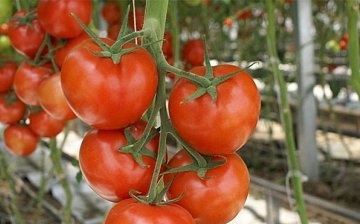
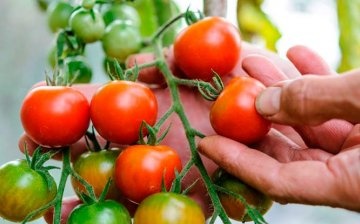
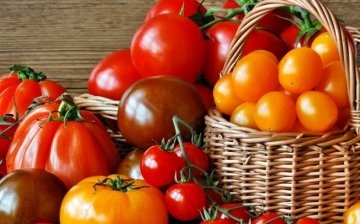
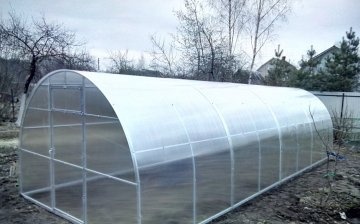

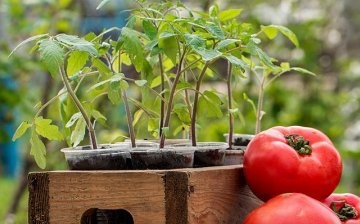
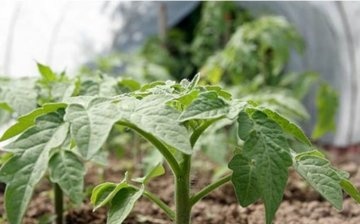
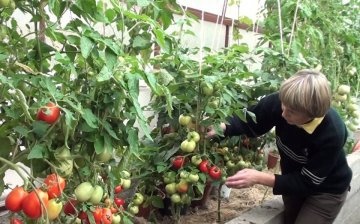
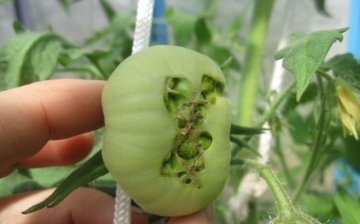
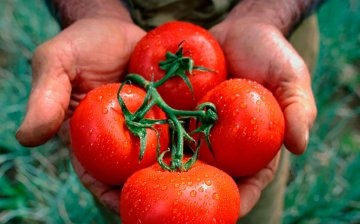










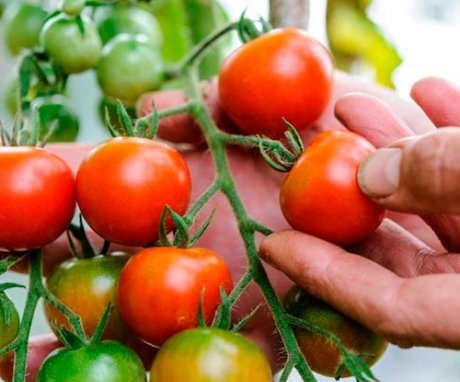

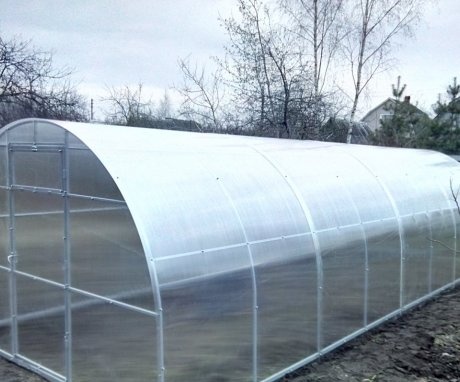

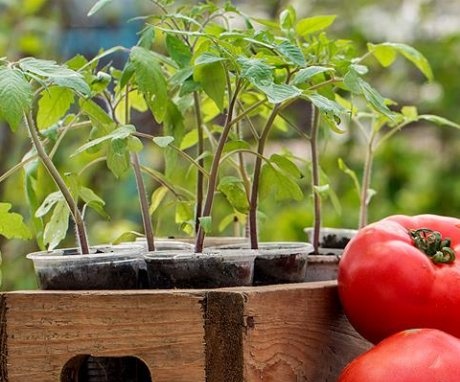
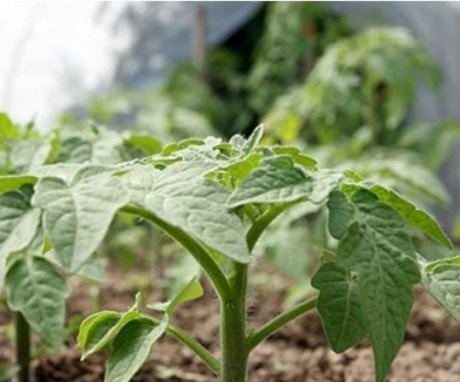
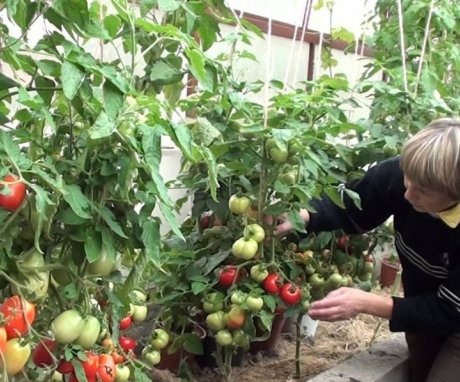
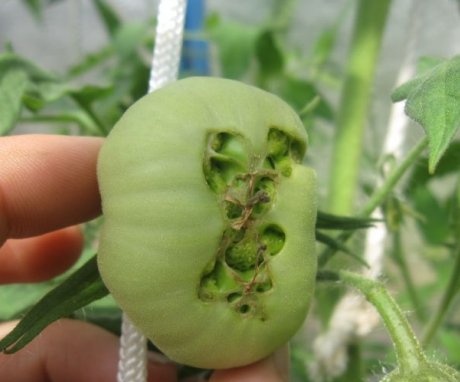
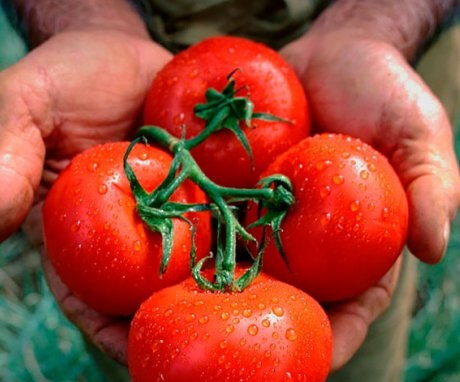
I only grow medium-sized tomatoes in my greenhouse, as for me this is the most suitable option. Large tomatoes are very watery, which is why I don't like them very much.